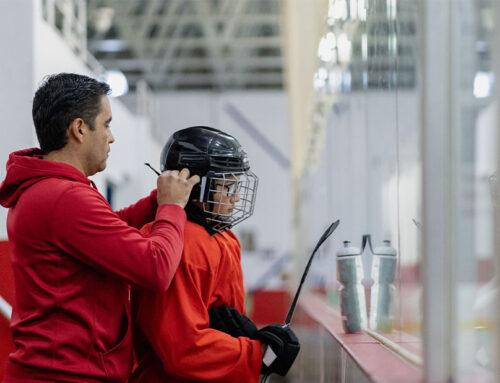How to Get a Football Scholarship: The Secrets You Need
Each year, more high school football players are seeking college scholarships than the total number available. Unless you’re a blue chipper being courted by several programs, it’s going to take some hard work to set yourself apart from others in the hunt.
Learning how to get recruited is not an easy process for most. In 2011- 2012, about 1.1 million athletes played high school ball. Those who aspired to earn a scholarship to play in college had 800 institutions to choose from. In the aggregate, only 31,679 football scholarships were available.
Scholarships by Division
NCAA Division I-FBS: 120 schools, 85 full scholarships per school
NCAA Division I-FCS: 125 schools, 63 scholarships per school (full or partial, but no more than 85 players allowed on scholarship)
NCAA Division II: 156 schools, 36 scholarships per school (full or partial, most partial)
NCAA Division III: 239 schools, zero scholarships (D-III offers no football scholarships, but players can receive academic scholarships or need-based grants)
NAIA: 92 schools, 24 scholarships per school (full or partial, most partial)
NJCAA (Junior Colleges): 68 schools, 85 scholarships per school
How to Get a Football Scholarship
Game Highlight Video
To get an edge on your competition, you can’t rely solely on your performance on the field. You must have a game highlight video. If a coach likes what he sees, the recruiting process begins. If not, it’s on to the next prospect.
Recruiting is all about getting the right person’s eyes on you. There are a few ways to do this: pay a recruiting company, sit back and hope a school finds you, or go out and promote yourself.
There are free or low-cost options to help you promote yourself. For about $50, you can buy low-end video editing software. Here are some tips on what your film should include:
Five minutes or less. College coaches do not have a lot of spare time to watch thousands of videos.
Put your best plays first. Coaches rarely watch entire videos, so don’t risk them not seeing your best plays!
Include only your best plays. You don’t need filler. Make the video short and impressive!
Combines and Tournaments
Another effective way to promote yourself is to attend combines and 7-on-7 tournaments. Do the research on these, because not all of them will help you. Those that capture video footage can help you much more than those that don’t. Remember this: most college coaches live by the mantra, “If I don’t see it, I don’t believe it.” Here are some tips on selecting the right combine or camp:
Look for money value. Lots of combines and 7-on-7s are held every year. Don’t get caught up in the hype of sponsors and celebrities. Find ones that will help you be seen by college coaches. That means you need video to document your performance (example video).
Beware of false promises. NCAA coaches can’t attend combines. These events should aid you in your recruiting process, but they are not the reason you will get a scholarship.
No substitute for game production. Combines and 7-on-7s are great for providing extra video to coaches, but the most important thing is whether you can play the game at that level.
Social Media
Social media is the great equalizer in recruiting. YouTube, Twitter and the online recruiting websites have helped players from smaller schools get noticed. It used to be hard for coaches to find players from such schools; but now, thanks to social media, a coach can view video of players from small schools and rural areas. Here are some tips for using social media in recruiting:
Again, look for money value. YouTube, Twitter, PlayNextLevel and NSCA have free options to post your game, combine and/or 7-on-7 videos. Some companies charge to help with recruiting. Do your research to determine whether you are likely to get a return on your investment.
Use it like a résumé. Use technology platforms to give a great first impression. Free recruiting websites allow you to upload your bio, game stats, measurements, notables (GPA, awards, etc.) and videos. Email position coaches at your target schools and link your profile to the emails. This gives coaches all they need to start the recruiting process.
Be careful what you post. Take down anything on Facebook or Twitter that you don’t want your grandmother to see. Colleges are looking for recruits with good character, so give them the impression that you want to play football, not party.
Game Plan
I recommend making a game plan using all the above tips. Sit down with your parents and coach to figure out which schools are the best fit for you. Factor in everything: academics, geography, potential playing time and potential teammates. Make a list of target schools, anywhere from five to 50. Break it down to 10 schools a night and research the position coach. Send each one a personal email to let him know about you and your desire to play for his program. Include your game video, combine video, GPA and ACT/SAT scores to evidence your talents both on and off the football field. This can turn up opportunities at schools that typically do not recruit from your area due to budget or staff limitations. Let each coach know that you like his school and, more important, that you can play at the level of his program. This is how you create your own opportunities to get recruited.
RECOMMENDED FOR YOU
How to Get a Football Scholarship: The Secrets You Need
Each year, more high school football players are seeking college scholarships than the total number available. Unless you’re a blue chipper being courted by several programs, it’s going to take some hard work to set yourself apart from others in the hunt.
Learning how to get recruited is not an easy process for most. In 2011- 2012, about 1.1 million athletes played high school ball. Those who aspired to earn a scholarship to play in college had 800 institutions to choose from. In the aggregate, only 31,679 football scholarships were available.
Scholarships by Division
NCAA Division I-FBS: 120 schools, 85 full scholarships per school
NCAA Division I-FCS: 125 schools, 63 scholarships per school (full or partial, but no more than 85 players allowed on scholarship)
NCAA Division II: 156 schools, 36 scholarships per school (full or partial, most partial)
NCAA Division III: 239 schools, zero scholarships (D-III offers no football scholarships, but players can receive academic scholarships or need-based grants)
NAIA: 92 schools, 24 scholarships per school (full or partial, most partial)
NJCAA (Junior Colleges): 68 schools, 85 scholarships per school
How to Get a Football Scholarship
Game Highlight Video
To get an edge on your competition, you can’t rely solely on your performance on the field. You must have a game highlight video. If a coach likes what he sees, the recruiting process begins. If not, it’s on to the next prospect.
Recruiting is all about getting the right person’s eyes on you. There are a few ways to do this: pay a recruiting company, sit back and hope a school finds you, or go out and promote yourself.
There are free or low-cost options to help you promote yourself. For about $50, you can buy low-end video editing software. Here are some tips on what your film should include:
Five minutes or less. College coaches do not have a lot of spare time to watch thousands of videos.
Put your best plays first. Coaches rarely watch entire videos, so don’t risk them not seeing your best plays!
Include only your best plays. You don’t need filler. Make the video short and impressive!
Combines and Tournaments
Another effective way to promote yourself is to attend combines and 7-on-7 tournaments. Do the research on these, because not all of them will help you. Those that capture video footage can help you much more than those that don’t. Remember this: most college coaches live by the mantra, “If I don’t see it, I don’t believe it.” Here are some tips on selecting the right combine or camp:
Look for money value. Lots of combines and 7-on-7s are held every year. Don’t get caught up in the hype of sponsors and celebrities. Find ones that will help you be seen by college coaches. That means you need video to document your performance (example video).
Beware of false promises. NCAA coaches can’t attend combines. These events should aid you in your recruiting process, but they are not the reason you will get a scholarship.
No substitute for game production. Combines and 7-on-7s are great for providing extra video to coaches, but the most important thing is whether you can play the game at that level.
Social Media
Social media is the great equalizer in recruiting. YouTube, Twitter and the online recruiting websites have helped players from smaller schools get noticed. It used to be hard for coaches to find players from such schools; but now, thanks to social media, a coach can view video of players from small schools and rural areas. Here are some tips for using social media in recruiting:
Again, look for money value. YouTube, Twitter, PlayNextLevel and NSCA have free options to post your game, combine and/or 7-on-7 videos. Some companies charge to help with recruiting. Do your research to determine whether you are likely to get a return on your investment.
Use it like a résumé. Use technology platforms to give a great first impression. Free recruiting websites allow you to upload your bio, game stats, measurements, notables (GPA, awards, etc.) and videos. Email position coaches at your target schools and link your profile to the emails. This gives coaches all they need to start the recruiting process.
Be careful what you post. Take down anything on Facebook or Twitter that you don’t want your grandmother to see. Colleges are looking for recruits with good character, so give them the impression that you want to play football, not party.
Game Plan
I recommend making a game plan using all the above tips. Sit down with your parents and coach to figure out which schools are the best fit for you. Factor in everything: academics, geography, potential playing time and potential teammates. Make a list of target schools, anywhere from five to 50. Break it down to 10 schools a night and research the position coach. Send each one a personal email to let him know about you and your desire to play for his program. Include your game video, combine video, GPA and ACT/SAT scores to evidence your talents both on and off the football field. This can turn up opportunities at schools that typically do not recruit from your area due to budget or staff limitations. Let each coach know that you like his school and, more important, that you can play at the level of his program. This is how you create your own opportunities to get recruited.
RECOMMENDED FOR YOU
Create A Free Recruiting Profile Today!
CaptainU helps athletes & parents not only be proactive but also to manage and take control of their entire recruiting journey.











